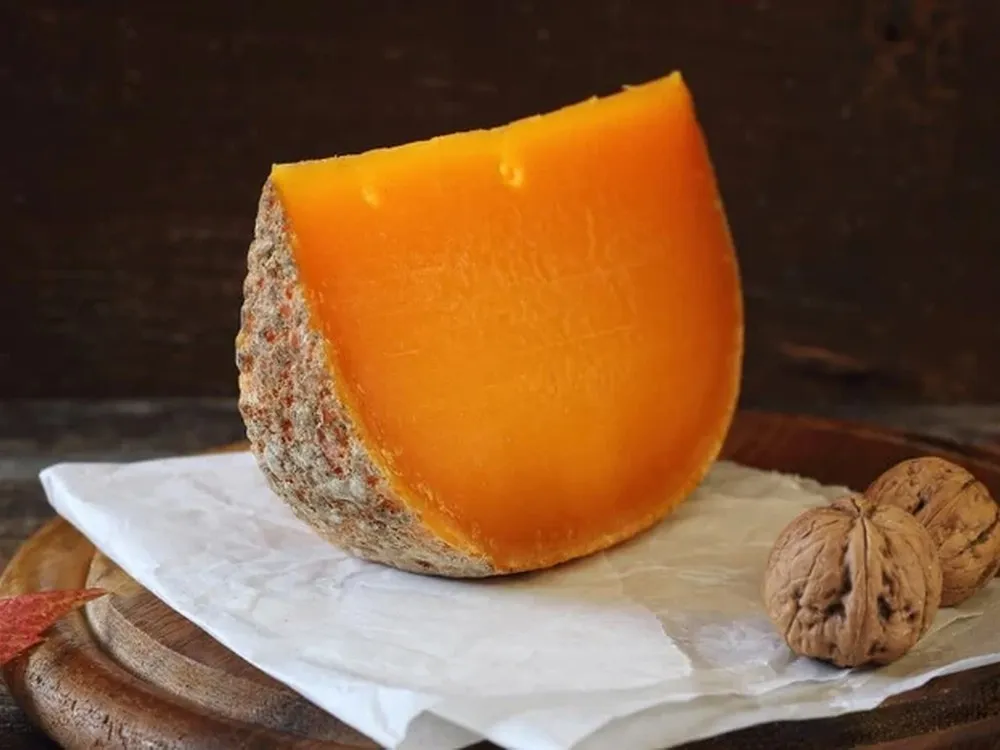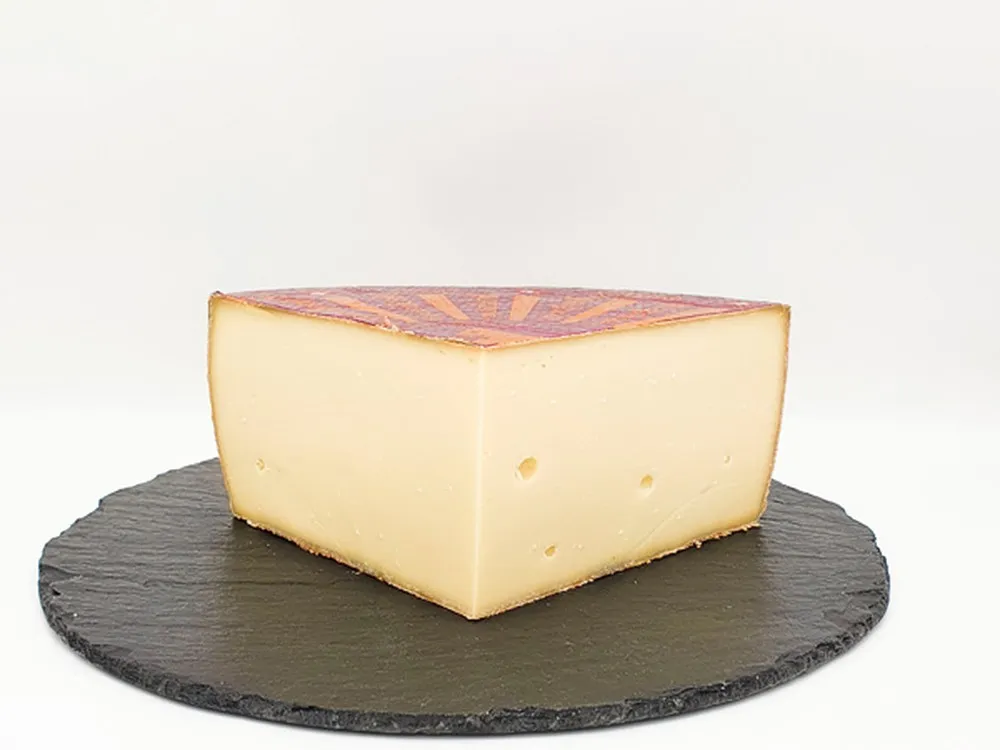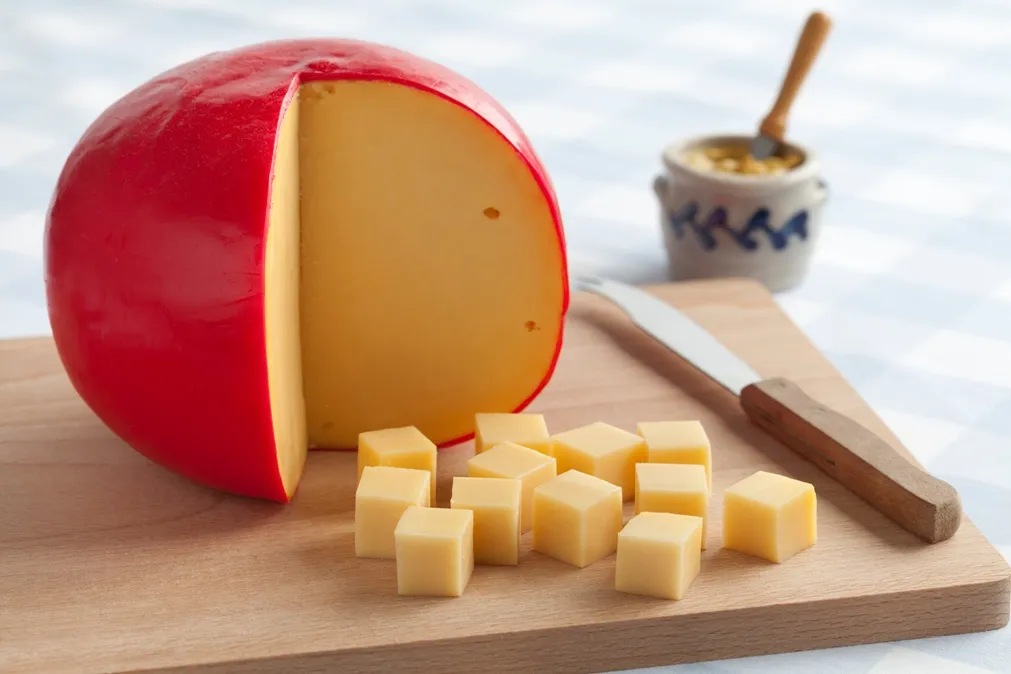Mimolette (Boule de Lille)
What is Mimolette Cheese? Why is Mimolette Banned?
The name 'Mimolette' is derived from the French word mi-mou, meaning "semi-soft." In France, it is famous as Boule de Lille, after the city of origin or Vieux Hollande, because it was initially inspired by the Dutch Edam cheese. It is a semi-hard cow's milk cheese that can be aged from 2 months to 24 months.
Mimolette has a spherical shape, and its bright orange color comes from the annatto. It is a good choice for non-vegetarians, and it has a bitter-sweet taste.
Mimolette cheese, also known as Boule de Lille, is a traditional French cheese that in recent years, has sparked both intrigue and controversy.
Known for its distinctive appearance and flavor, Mimolette has a rich history that dates back several centuries. The name 'Mimolette' is derived from the French word mi-mou, meaning "semi-soft." In France, it is famous as Boule de Lille, after the city of origin or Vieux Hollande, because it was originally inspired by the Dutch Edam cheese. This semi-hard cow's milk cheese matured for anywhere from two to 24 months, though around twelve months is typical.
In recent years, this unique cheese has faced a ban in the United States, a decision that has left many cheese enthusiasts and food connoisseurs questioning. In this article, we will delve into the origins of Mimolette cheese, how it is made, its taste profile, and the curious reason behind its ban.
What Kind of Cheese is Mimolette?
Mimolette cheese is a semi-hard cheese that hails from the northeastern region of France, particularly the city of Lille. It is made from cow's milk and has a vibrant orange color that sets it apart from other cheeses. The cheese is usually aged for a considerable period and although young cheeses are available, much older ones are the norm. Mimolette is often likened to the more well-known Dutch cheese, Edam, due to its spherical shape and bold flavor.
During the aging process, Mimolette develops a distinct flavor profile that can range from nutty and caramelized to slightly salty with a hint of butterscotch. The aging of Mimolette is a meticulous process that involves regular turning and brushing of the cheese to ensure proper air circulation and development of its characteristic crust. This crust, formed by tiny cheese mites that burrow into the rind, is a unique feature of Mimolette and adds to its complex flavor.
When it comes to pairing, Mimolette's bold taste and firm texture make it a versatile cheese for various culinary applications. It can be enjoyed on its own as a table cheese, grated over salads or pasta dishes, or paired with fruits and nuts for a delightful cheese board. The vibrant orange hue of Mimolette also adds a pop of color to any cheese platter, making it visually appealing in addition to its delicious taste.
How Is Mimolette Cheese Made?
The process of making Mimolette cheese is a fascinating one. It starts with pasteurizing cow's milk. Rennet is added to thicken the milk, and once the curds form, they are cut into small pieces and gathered into molds. These molds are then pressed to expel any remaining whey and shape the cheese into its distinctive ball shape, setting it apart from other cheeses.
After being removed from the molds, the cheese is then rubbed with annatto – a natural food coloring derived from the seeds of the achiote tree. This gives Mimolette its characteristic orange hue. The cheese is then placed in a temperature and humidity-controlled cave to age. During the aging process, the cheese is carefully monitored and turned regularly to ensure even maturation.
As Mimolette cheese ages, it develops more intense flavors. The aging process can range from a few months to several years, with longer aging times resulting in a more intense and complex taste. The cheese's texture also evolves during aging, becoming firmer and more crumbly with time.
During the aging period, natural rinds may form on the surface of the cheese, adding depth of flavor and protecting the interior as it matures. These rinds are a result of the cheese interacting with the cave environment, allowing for the development of beneficial molds and bacteria that contribute to the cheese's final taste and texture.
What Does Mimolette Cheese Taste Like?
Mimolette cheese offers a truly unique flavor experience. It has a nutty and savory taste with hints of caramel and butterscotch, a combination that is sure to tantalize your taste buds. The cheese's aging process contributes to its distinctive texture, which ranges from smooth and creamy when young to crumbly and granular with age. Mimolette can also develop tiny calcium lactate crystals known as "crunchy bits," adding a delightful texture to the cheese. Its flavor becomes more pronounced and intense as it ages, making it a favorite among cheese connoisseurs.
How To Eat Mimolette Cheese?
Mimolette cheese can be enjoyed in any number of ways. Its bold flavor pairs well with a variety of accompaniments, such as crusty bread, dried fruits, and nuts. For a simple yet delicious experience, try thinly slicing Mimolette and serving it on a cheese platter. It also lends itself well to melting, making it a fantastic addition to gratins and savory dishes. Additionally, Mimolette can be grated and used as a topping for pasta or salads, adding a burst of flavor to any dish it graces.
Does Mimolette Still Have Mites When Eaten?
One of the most intriguing aspects of Mimolette cheese is the presence of microscopic mites. Initially, these mites were intentionally introduced as part of the aging process, as they help to create the unique flavors and textures found in mature Mimolette. However, concerns over food safety led to a ban on Mimolette cheese in the United States. The ban came into force due to the presence of these mites, as there were concerns about potential allergenic reactions in some individuals.
It's important to note that the mites are harmless when consumed. They can simply be brushed off the surface of the cheese before consumption. Despite the ban, Mimolette remains highly sought after in Europe and other parts of the world, where the mite presence is embraced as part of the cheese's charm and flavor. Rest assured, Mimolette is a safe and delicious cheese to enjoy.
Why was Mimolette Banned?
In 2013, the Food and Drug Administration (FDA) banned the importation and sale of Mimolette cheese in the United States. This ban was not due to any health concerns or safety issues with the cheese itself but rather because of the presence of cheese mites, which are considered to be an allergen. The FDA deemed that the mites posed a potential health risk to consumers with allergies or sensitivities.
While the ban did disappoint many Mimolette enthusiasts, it's worth noting that the FDA's decision was based on preventive measures. The presence of mites in Mimolette is part of its traditional production process and has not caused any significant health issues. The ban by the FDA (USA) was lifted in 2022 for several versions of Mimolette except for the Mimolette “Extra Vieille”.
Conclusion
Mimolette cheese is a unique and flavorful cheese that has captivated the taste buds of cheese enthusiasts around the world. Despite its ban in the United States for the “Extra Vieille” version of the cheese, Mimolette continues to be cherished for its distinctive taste and texture. Whether enjoyed on its own, paired with complementary flavors, or used in various culinary creations, Mimolette cheese brings a touch of French tradition to any dining experience. While the ban may limit its availability, the allure of Mimolette and its long-standing history will continue to intrigue cheese lovers for generations to come.

Over 200,000 page views per month, Put your store on our map!
Contact UsOther French cheeses:
Mimolette cheese, renowned for its unique orange color and distinctive nutty flavor, is a beloved choice for many cheese enthusiasts. However, there may be instances where you need to find a substitute for Mimolette. Whether it's due to unavailability in your local grocery store or a desire to explore different …
Read MoreMimolette (Boule de Lille) Q & A
-
Is Mimolette Cheese Lactose-Free?
While Mimolette cheese is not entirely lactose-free, it contains significantly less lactose compared to fresh cheeses. During the aging …
Read More -
Is Mimolette Cheese Vegetarian?
Mimolette cheese is not vegetarian-friendly. Although it does not contain any meat or animal flesh, traditional Mimolette production involves …
Read More -
Is Mimolette Cheese Gluten-Free?
Great news for individuals with gluten sensitivities or celiac disease – Mimolette cheese is naturally gluten-free. Produced solely from …
Read More - Does Mimolette Cheese Melt?
-
How To Store Mimolette Cheese
Proper storage is vital to maintain the quality and taste of Mimolette cheese. After each use, wrap the cheese …
Read More -
How Long Can Mimolette Cheese Sit Out?
Mimolette cheese should not be left unrefrigerated for extended periods. Bacteria can quickly multiply at room temperature, increasing the …
Read More -
Can You Freeze Mimolette Cheese?
If you find yourself with a surplus of Mimolette cheese, freezing it is an option. Unfortunately, freezing can affect …
Read More -
Can Dogs Eat Mimolette Cheese?
As for our furry friends, Mimolette cheese can be offered in moderation. Cheese can provide dogs with a good …
Read More -
Can Cats Eat Mimolette Cheese?
While a small amount of cheese can be given as an occasional treat, it is important to remember that …
Read More -
Can You Eat Mimolette Cheese While Pregnant?
For pregnant women, the safety of the foods they consume is of utmost importance. Fortunately, Mimolette cheese is generally …
Read More






